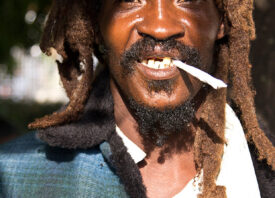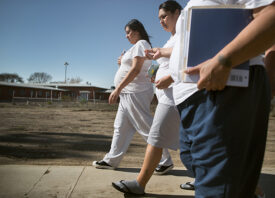Search this site
In Photographs Made of Sugar, A Brutal History Revealed


The artist Christina Leslie’s father grew up in Morant Bay, the capital of the parish of St. Thomas, Jamaica, and she’s been visiting since she was a young child. For the Christmas holidays, the whole family would return to her father’s hometown to see her grandparents, relatives, and family friends. St. Thomas, once known primarily as a sugar-growing parish, is a place she knows well, and it’s one with happy memories. But as an adult, she’s also come to learn more about its complicated history–and the brutal legacy of the sugar trade in the Caribbean islands.
Before the end of the 17th century, a quarter of a million enslaved African people were brought to Jamaica, Barbados, and the Leeward Islands, where they were forced to work on sugar plantations, places notorious for their harsh conditions.* Thousands were killed in the production of sugar. In the decades following emancipation, colonial violence persisted: in October of 1865, a group of farmers in Morant Bay (many formerly enslaved) protested against unjust conditions before they were violently suppressed, with hundreds killed.
Today, the scars of slavery remain, in Jamaica as in the United States, but in some cases, they’ve been deliberately hidden from view. “There is one particular property, which I will not name, that was formerly a plantation and is now a world-renowned golf destination,” Leslie tells me now. “I often wonder if any of these golfers are aware that they are golfing on grounds where 100 enslaved Africans once toiled on the cane fields.”
With Sugar Coat, the artist is bringing that history to the surface by creating pictures made of the granulated substance. The images themselves are emulsion lifts, fine and delicate objects similar to stained glass. They incorporate original photographs conceptualized by Leslie with help from models, some inspired by the stories of enslaved people; photographs from places of significance in Jamaica; and appropriated historical materials. What you see here are the re-photographed versions of those emulsion lifts, created to preserve images that would otherwise be too fragile to distribute widely.
We asked Leslie about her creative process, the inextricable history of sugar and slavery, and the potential for reparations going forward.
How and when did the idea for this project begin to take shape for you?
“This project evolved from an earlier concept I had concerning the African diaspora. I aspired to produce a series that would function as an anthology centered on Black History. I envisioned completing the project in a succession of chapters—before enslavement, the years our history was interrupted due to the slave trade, as well as the aftermath and future.
“I had invested a significant amount of time on the first chapter (which is still in progress) before attempting to experiment with the second chapter, which became Sugar Coat. I began reading a variety of books about the sugar trade in Jamaica, Barbados, and the Leeward Islands. I felt from a contemporary art perspective there was a substantial number of artworks about the cotton industry, but the history of sugar was often neglected.”
I’ve read a bit about the violent scars of the sugar industry in the United States, but might you tell me a bit about how the sugar industry has affected (and continues to affect) Jamaica as well?
“The history of the slave trade/sugar industry has several branches, some of which include the history of the Jamaican Maroons who were forced to Nova Scotia, Canada, and eventually left to Freetown, Sierra Leone.
“Today, many of the plantations in Jamaica, or great houses as they are often known, continue to earn revenue through the fees charged to tourists and residents who visit these sites for parties and weddings. These are sites that have witnessed an unfathomable number of crimes against humanity, but whose histories have been whitewashed in order to make them more palatable to tourists.
“Furthermore, the town of Morant Bay in Jamaica’s Parish of St. Thomas, where my father is from, has a tumultuous history with the sugar trade sector and is the scene of the Morant Bay Rebellion.
“Recently, with the Duke and Duchess of Cambridge’s visit to Jamaica in March 2022, the royal couple was criticized for Britain’s lack of reparations and atonement for slavery. While Prince William emphasized his anti-slavery stance, he made no overt apologies for the Crown’s role in the slave/sugar trade. On the final day of the expedition to mark Queen Elizabeth II’s Diamond Jubilee, Jamaica’s Prime Minister announced that the government would consider a similar move as Barbados to remove Queen Elizabeth II as head of state.”

In what ways can the scars of sugar’s history be seen in the modern sugar industry? “The “Caribbean’s main exports are still coffee and rum, both of which are manufactured from or, in the case of coffee, adjacent to sugar. There are still regions in the Caribbean where sugar is harvested manually, and workers are frequently underpaid, despite the fact that major sugar corporations profit from their labour.”
Can you tell me a bit about your personal archives from Jamaica, which have been incorporated into Sugar Coat?
“I’ve been going to Jamaica since I was a child. As I grew older, I began to travel more frequently and on my own. I regularly travel with my camera to document my trips and the numerous places I visit. In 2018, I made it a point to photograph Morant Bay and the nearby villages of Seaforth and Portland Parish. I wanted to photograph the places that were significant to him as a child in Jamaica. Some of the photographs depict sites, such as my grandfather’s house, while others depict members of the community and family/friends.”
What about the new images you created with models, costumes, and props? Who are your models?
“The selected models were friends who are also of Caribbean/African descent and who were able to trace their ancestry and lineage to this location. This was a crucial choice since the objective was to produce an authentic body of work based on generational heritage to which the actors could relate while playing out my desired themes and roles.”
Can you tell me a bit about the research that went into this project? Where did the appropriated literature come from?
“Some of Sugar Coat’s image-making method is appropriation. Appropriation is simply defined as the deliberate borrowing, reproduction, and alteration of existing images and items. Some of the visuals in this series were generated from historical pro-slavery literature and sugar advertisements. I composited images of my model, locations, and advertisements to make new photographs, or I reused brand posters to create my sugar emulsions.
“Additionally, I found a 1788 Jamaica Gazette piece announcing the escape of two enslaved women named Hope and Present. This prompted me to make a smaller series of images inspired by their escape. I also made photos based on my studies on slave auctions and news announcements from the time announcing the sale of enslaved labour.”

Did you uncover anything that surprised you during your research?
“Several instances throughout my investigation shook me. Some were truly horrifying and demonstrated the sheer depravity of humanity.
“But I will share this discovery from my research. Some of the foods we consume now can be traced back to the sugar trade industry. Women were bred as chattel because slavery was regarded as an economic enterprise. Sadly, because they were malnourished, they were unable to carry their pregnancies to term. The governor of Jamaica (also a slave owner) at the time was concerned and requested that a specific physician Hans Sloane investigate his ‘chattel.’
“Sloane was said to have concocted a chocolate malt-like drink to aid these women’s nourishment. However, since cocoa tasted so bitter, sugar was added to sweeten the flavour and offer energy. It was later reported that Cadbury chocolate used Sloane’s recipe for their own chocolate enterprise after the recipe was sold to them.”
Can you walk us through the process of physically creating and printing these artworks?
“Creating Sugar Coat was a labour-intensive process that required extensive research, testing, and numerous trial and error iterations. I was extremely intentional in my aesthetic choices and the way I made each image, with the materiality of sugar as the starting point.
“I chose white sugar over natural brown sugar to allude to the racist mindset of purification. According to several sources, white was regarded a desirable colour, even though refined sugar consumption causes a slew of health problems as compared to natural, unrefined sugar. Using white sugar alludes to whiteness and the erroneous belief that it is good and pure. It is the eradication of the black hands responsible for its manufacture.
“Each photograph is made with a special paper and a sugar solution that I invented that eventually turns into an emulsion lift. A single image takes roughly four days to create. After drying and hardening, the images become encased in sugar; after 24-48 hours they become 3-D objects. Only when light shines behind the object can the image be seen. The image is subsequently transformed into what looks like a stained glass and becomes a temporal collectible, an artefact, and an archival record.
“I then rephotograph the images to turn them back into a 2-D object for the purposes of having two ways of presenting my images. The 3-D lifts will erode and disintegrate over time, and rephotographing is the only means of preservation.”

How have people responded to the work so far? Do you find that most people know about this painful history, or has it largely been overlooked?
“When I’ve shared this series, I received some abhorrent remarks, while others appear to be captivated by my method but uninterested in the conceptual component. I believe few are aware of the implications this industry had on the Caribbean islands and, for the most part, associate the Trans-Atlantic slave trade with African American History. Consequently, the people who suffered in the production of Caribbean exports have never benefited monetarily and the psychological, economic, and social-political consequences of colonialism continue to affect the Caribbean Diaspora.
“Our bodies, stories, and identities are stitched and transformed by sugar. Most people I have found to be terribly ignorant of this fact unless, of course, they share this personal history themselves.”

This is a big question, but in what ways, if any, do you see today’s artists and photographers righting some of history’s wrongs? And relatedly, what makes this moment in history an important turning point?
“While I hate stating it, I feel George Floyd’s murder was the catalyst or tipping point that made people more aware of many historical injustices that have penetrated our current sociopolitical climate.”
“People in Canada, where I live, for example, are being presented with hard facts and visual evidence that horrific atrocities were committed against our Indigenous population as a result of the discovery of hundreds of children’s graves on residential school sites. That bothers me because it seems as if people must see it to believe it. They needed to see the graves of these Indigenous children or see George’s untimely and unlawful death on camera before they could accept both of these horrible occurrences had occurred.
“However, for numerous years, artists have used their platforms to raise awareness of these instances or history. Consider Kara Walker’s metaphoric ‘cut-outs,’ which show the magnitude and intensity of the racial and generational suffering inflicted on Black people throughout the Slave Trade. Her sugar Sphinx was a stinging criticism of capitalism and the sugar trade.
“In Canada, long before wearing a ‘orange t-shirt’ became popular, Canadian artist Kent Monkman’s 2017 artwork ‘The Scream’ referred to the atrocities of residential school institutions.
“Are artists striving to right historical wrongs? I’m not certain, but I feel that all of the artists I admire and find fascinating are aiming to educate the general public about some of humanity’s traumatic pasts. At the very least, they are laying the groundwork for difficult conversations to take place; will this result in restitution or reparations? Only time will tell.”

All images © Christina Leslie
*Leslie consulted the book Sugar and Slaves: The Rise of the Planter Class in the English West Indies, 1624-1713 by the historian Richard S. Dunn as part of her research.


